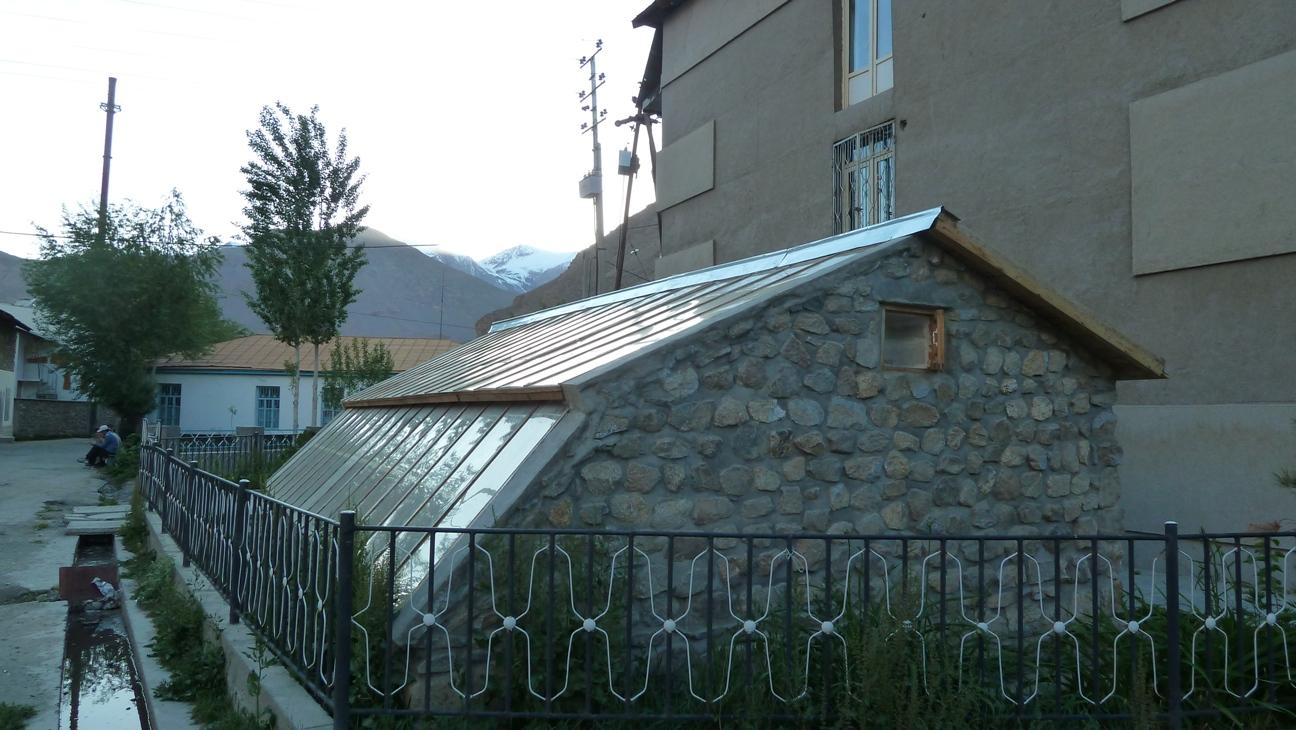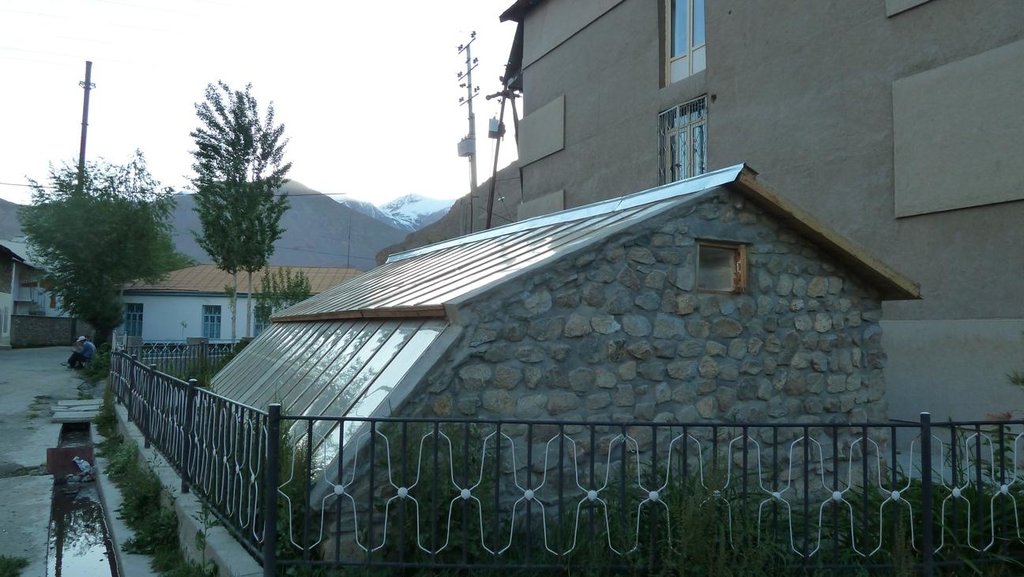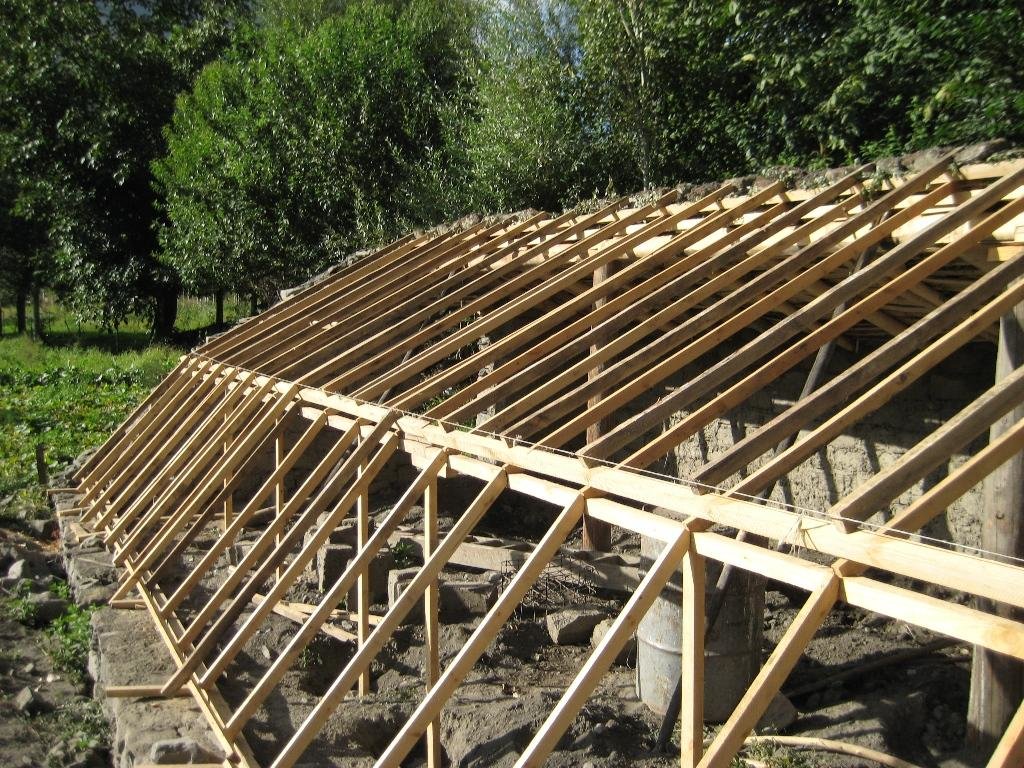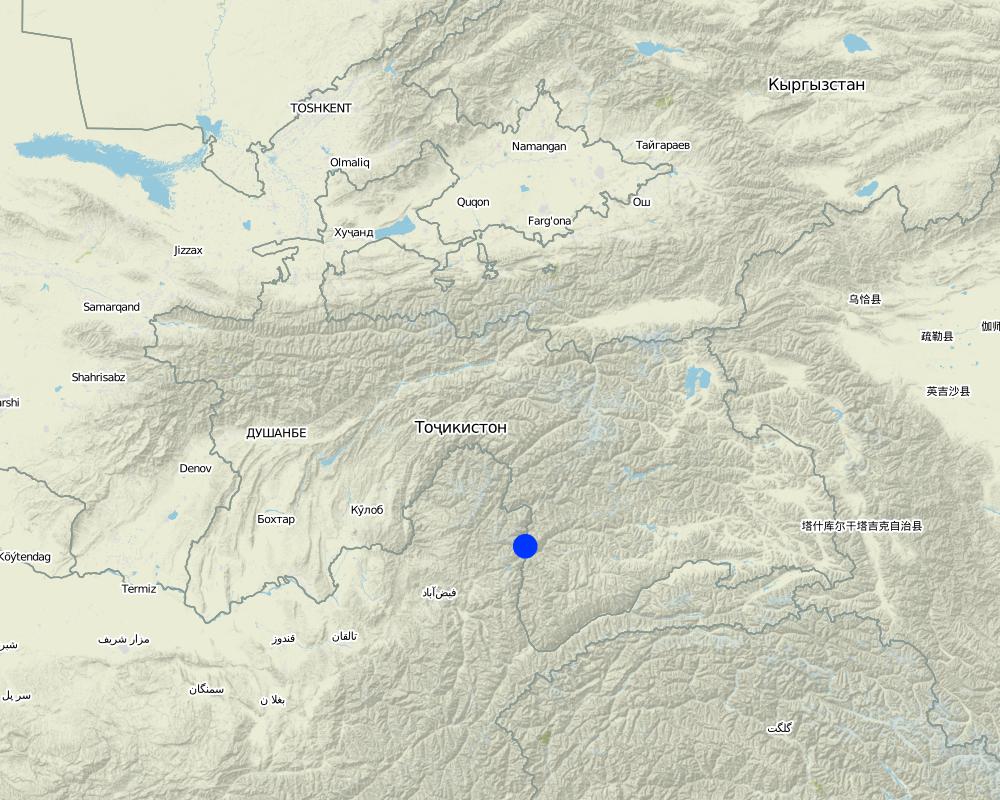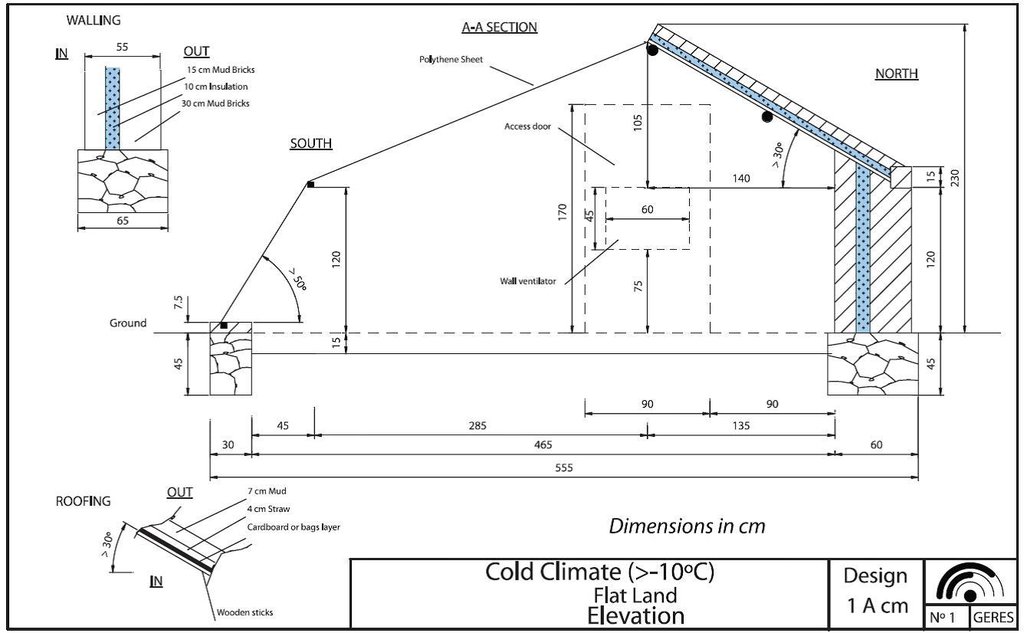Passive solar greenhouses for winter commercial vegetable production [塔吉克斯坦]
- 创建:
- 更新:
- 编制者: Julie Zähringer
- 编辑者: –
- 审查者: David Streiff, Alexandra Gavilano
technologies_1041 - 塔吉克斯坦
- Passive solar greenhouses for winter commercial vegetable production: March 21, 2017 (inactive)
- Passive solar greenhouses for winter commercial vegetable production: July 28, 2017 (inactive)
- Passive solar greenhouses for winter commercial vegetable production: Aug. 19, 2019 (inactive)
- Passive solar greenhouses for winter commercial vegetable production: Nov. 2, 2021 (public)
查看章节
全部展开 全部收起1. 一般信息
1.2 参与该技术评估和文件编制的资源人员和机构的联系方式
SLM专业人员:
Khudonazarov Artur
Manager of the "Centre for Sustainable and Innovative Technology", a project of MSDSP
塔吉克斯坦
SLM专业人员:
Shariff Jamil
MSDSP
有助于对技术进行记录/评估的机构名称(如相关)
Kyrgyzstan Mountain Societies Development Support Programme, Aga Khan Development Network (MSDSP KG) - 吉尔吉斯斯坦1.3 关于使用通过WOCAT记录的数据的条件
编制者和关键资源人员接受有关使用通过WOCAT记录数据的条件。:
是
2. SLM技术的说明
2.1 技术简介
技术定义:
Passive solar greenhouses heated entirely by sunlight were established with the aim to produce vegetables for commercial use during the harsh winter conditions.
2.2 技术的详细说明
说明:
A passive solar greenhouse is a greenhouse heated entirely by sunlight, with no additional fuel-based heating. In the Pamirs, the temperature inside these greenhouses can be kept high enough to grow vegetables throughout the year, even in winter if the greenhouse is built efficiently. Thus greenhouses can be of great use, particularly in those areas where there are continuing concerns about food security and economic development. These greenhouses were developed by GERES (Renewable Energy and Environment Group) and ICIMOD (International Centre for Integrated Mountain Development) and first tested with farmers in Ladakh, India. MSDSP adopted the idea and introduced it to the GBAO region in Tajikistan establishing 3 demonstration greenhouses in collaboration with farmers in the Shugnan district in 2010.
Purpose of the Technology: A solar greenhouse aims to trap and intensify the heating effect of solar radiation and thus enables plants to be grown that cannot be grown under the normal (outside) ambient conditions. Solar greenhouses are particularly useful in areas where there is a lot of sunshine in winter, but where the air is too cold for growing crops. The main benefits of solar greenhouses are that vegetables can be grown during the winter, helping to fulfill basic subsistence needs of people in remote areas and income generation through selling the produce.
Establishment / maintenance activities and inputs: A greenhouse is only efficient if it is constructed in the right place, in the right way, and is used properly. An efficient solar greenhouse should be designed along an east-west axis, with the length of the south face increased and angled to present the largest possible surface area to the sun, the size of the east and west facing walls reduced to minimise heat loss and provide shade inside the greenhouse, and the north wall should be heavily insulated.
The following steps are required in constructing an efficient greenhouse: (1) selecting an appropriate place: there needs to be a source of running water close to the greenhouse, solar radiation needs to be sufficient (sunrise should be before 9.30 and sunset after 3.00 pm even on the shortest days of the year), the land has to be flat and dry; (2) selecting the most appropriate design: (see manual); (3) constructing the foundation: digging a trench and filling the foundation with mud mortar; (4) preparing the floor; (5) building the double walls separated by one insulation layer; (6) making and installing an access door; (7) making and installing the wall ventilator; (8) constructing the roof; (9) making and installing the roof ventilator (shutter); (10) installing the polyethylene shutter; (11) installing night insulation.
Natural / human environment: The greenhouses were established in three villages of Shugnan district: Buni, Sokhcharv and Darmoracht. Two of these villages are located at about 2,500 metres a.s.l. and receive less than 300 mm of annual precipitation. The farmers who constructed these greenhouses are small-scale farmers with less than 0.5 ha of land available.
2.3 技术照片
2.5 已应用该技术的、本评估所涵盖的国家/地区/地点
国家:
塔吉克斯坦
区域/州/省:
Tajikistan
有关地点的进一步说明:
GBAO/Shugnan
注释:
At least 3 greenhouses built in Shugnan district, each one is 50 m2 in size.
Map
×2.6 实施日期
如果不知道确切的年份,请说明大概的日期:
- 不到10年前(最近)
2.7 技术介绍
详细说明该技术是如何引入的:
- 通过项目/外部干预
注释(项目类型等):
2010
3. SLM技术的分类
3.1 该技术的主要目的
- 改良生产
3.2 应用该技术的当前土地利用类型

农田
- 一年一作
- Cucumbers, tomatoes, radishes, salad greens, onions
每年的生长季节数:
- 1
具体说明:
Longest growing period in days: 170Longest growing period from month to month: late April-early October

定居点、基础设施
- 定居点、建筑物
注释:
Major land use problems (compiler’s opinion): A lack of precipitation and therefore irrigation water, soil erosion, low soil fertility (no fertilisers used or rotations), harsh climatic conditions (high altitude).
Future (final) land use (after implementation of SLM Technology): Cropland: Ca: Annual cropping
3.3 由于技术的实施,土地使用是否发生了变化?

农田
- 一年一作

定居点、基础设施
3.4 供水
该技术所应用土地的供水:
- 充分灌溉
3.5 该技术所属的SLM组
- 家庭花园
- greenhouse
3.6 包含该技术的可持续土地管理措施

农艺措施
- A2:有机质/土壤肥力

结构措施
- S11:其它
注释:
Main measures: agronomic measures, structural measures
Type of agronomic measures: manure / compost / residues
3.7 该技术强调的主要土地退化类型

化学性土壤退化
- Cn:肥力下降和有机质含量下降(非侵蚀所致)

生物性退化
- Bq:数量/生物量减少
- Bs:质量和物种组成/多样性的下降
注释:
Main type of degradation addressed: Cn: fertility decline and reduced organic matter content, Bq: quantity / biomass decline, Bs: quality and species composition /diversity decline
Main causes of degradation: soil management (no application of fertilisers), deforestation / removal of natural vegetation (incl. forest fires), overgrazing, change of seasonal rainfall (decreased), droughts
Secondary causes of degradation: war and conflicts (during the civil war a lot of vegetation was cut to provide energy)
3.8 防止、减少或恢复土地退化
具体数量名该技术与土地退化有关的目标:
- 防止土地退化
4. 技术规范、实施活动、投入和成本
4.1 该技术的技术图纸
技术规范(与技术图纸相关):
The diagram shows a greenhouse adapted to a cold climate, for greenhouses adapted to different climates please see the manual (annex 1)
GBAO
Date: 2004
Technical knowledge required for field staff / advisors: high
Technical knowledge required for land users: moderate (brochures available in Tajik)
Main technical functions: increase in organic matter, reduction in wind speed, increase of biomass (quantity), spatial arrangement and diversification of land use, production of microclimate suitable for crop growth in winter
Manure / compost / residues
Material/ species: manure is mixed with the soil to cover the floor of the greenhouse
Structural measure: greenhouse
Construction material (earth): mud
Construction material (stone): stone
Construction material (wood): wood (poplar, willow)
Construction material (other): straw, wool
作者:
GERES / ICIMOD
4.2 有关投入和成本计算的一般信息
其它/国家货币(具体说明):
Somoni
如相关,注明美元与当地货币的汇率(例如1美元=79.9巴西雷亚尔):1美元=:
4.5
注明雇用劳工的每日平均工资成本:
9.00
4.3 技术建立活动
| 活动 | 时间(季度) | |
|---|---|---|
| 1. | Digging trench for fundament, 60 cm deep | spring |
| 2. | Put fundament using stones mixed with mud | |
| 3. | Build walls: outer layer stones (40 cm width), then insulation layer with straw or wool (10 cm), inner layer out of mudbricks (15-20 cm). Total height of wall is 1.20 m. | |
| 4. | Build doors | |
| 5. | Build wall ventilators | |
| 6. | Build roof: southfacing side put 2 layers of each 40m2 cellophane, northfacing side put woodlogs | |
| 7. | Build roof ventilators | |
| 8. | Install night insulation |
4.4 技术建立所需要的费用和投入
| 对投入进行具体说明 | 单位 | 数量 | 单位成本 | 每项投入的总成本 | 土地使用者承担的成本% | |
|---|---|---|---|---|---|---|
| 劳动力 | Digging trench for fundament, | Persons/day | 3.0 | 40.0 | 120.0 | 100.0 |
| 劳动力 | Put fundament | Persons/day | 10.5 | 40.0 | 420.0 | 100.0 |
| 劳动力 | Build walls | Persons/day | 30.0 | 40.0 | 1200.0 | 100.0 |
| 劳动力 | Build doors | Persons/day | 2.0 | 20.0 | 40.0 | 100.0 |
| 设备 | Shovels | Pieces | 2.0 | 20.0 | 40.0 | 100.0 |
| 设备 | Nails | kg | 3.0 | 10.0 | 30.0 | |
| 施工材料 | Cellophane foil | sq m | 80.0 | 4.0 | 320.0 | |
| 其它 | Labour: Build wall ventilators | Persons/day | 12.0 | 40.0 | 480.0 | 100.0 |
| 其它 | Labour: Build roof ventilators | Persons/day | 4.0 | 40.0 | 160.0 | 100.0 |
| 其它 | Labour: Install night insulation | Persons/day | 5.0 | 40.0 | 200.0 | 100.0 |
| 技术建立所需总成本 | 3010.0 | |||||
| 技术建立总成本,美元 | 668.89 | |||||
如果土地使用者负担的费用少于100%,请注明由谁负担其余费用:
MSDSP
注释:
Duration of establishment phase: 1.5 month(s)
4.5 维护/经常性活动
| 活动 | 时间/频率 | |
|---|---|---|
| 1. | Replace cellophane | when needed, every 1-2 years for bad material, 5 years for good material |
4.6 维护/经常性活动所需要的费用和投入(每年)
| 对投入进行具体说明 | 单位 | 数量 | 单位成本 | 每项投入的总成本 | 土地使用者承担的成本% | |
|---|---|---|---|---|---|---|
| 劳动力 | Replace cellophane | Persons/day | 2.0 | 40.0 | 80.0 | 100.0 |
| 施工材料 | Cellophane | sq m | 80.0 | 4.0 | 320.0 | 100.0 |
| 技术维护所需总成本 | 400.0 | |||||
| 技术维护总成本,美元 | 88.89 | |||||
注释:
The costs were calculated for the establishment of one 5x10m greenhouse.
4.7 影响成本的最重要因素
描述影响成本的最决定性因素:
Apart from the cellophane cover, mainly local materials were used which did not require investments. If labour has to be paid, this is the most determinate factor, also wooden poles if they have to be bought.
5. 自然和人文环境
5.1 气候
年降雨量
- < 250毫米
- 251-500毫米
- 501-750毫米
- 751-1,000毫米
- 1,001-1,500毫米
- 1,501-2,000毫米
- 2,001-3,000毫米
- 3,001-4,000毫米
- > 4,000毫米
有关降雨的规范/注释:
200-300 mm
农业气候带
- 干旱
Thermal climate class: temperate
5.2 地形
平均坡度:
- 水平(0-2%)
- 缓降(3-5%)
- 平缓(6-10%)
- 滚坡(11-15%)
- 崎岖(16-30%)
- 陡峭(31-60%)
- 非常陡峭(>60%)
地形:
- 高原/平原
- 山脊
- 山坡
- 山地斜坡
- 麓坡
- 谷底
垂直分布带:
- 0-100 m a.s.l.
- 101-500 m a.s.l.
- 501-1,000 m a.s.l.
- 1,001-1,500 m a.s.l.
- 1,501-2,000 m a.s.l.
- 2,001-2,500 m a.s.l.
- 2,501-3,000 m a.s.l.
- 3,001-4,000 m a.s.l.
- > 4,000 m a.s.l.
关于地形的注释和进一步规范:
Landforms: plateau / plains, hill slopes, footslopes, valley floors
5.3 土壤
平均土层深度:
- 非常浅(0-20厘米)
- 浅(21-50厘米)
- 中等深度(51-80厘米)
- 深(81-120厘米)
- 非常深(> 120厘米)
土壤质地(表土):
- 粗粒/轻(砂质)
表土有机质:
- 低(<1%)
如有可能,附上完整的土壤描述或具体说明可用的信息,例如土壤类型、土壤酸碱度、阳离子交换能力、氮、盐度等。:
Soil fertility is low
Soil drainage / infiltration is medium
Soil water storage capacity is medium
5.4 水资源可用性和质量
地下水位表:
< 5米
地表水的可用性:
好
水质(未处理):
不良饮用水(需要处理)
关于水质和水量的注释和进一步规范:
Water availability is good because area is close to river.
5.5 生物多样性
物种多样性:
- 低
5.6 应用该技术的土地使用者的特征
生产系统的市场定位:
- 混合(生计/商业)
- 商业/市场
非农收入:
- 低于全部收入的10%
相对财富水平:
- 平均水平
个人或集体:
- 个人/家庭
机械化水平:
- 畜力牵引
- 机械化/电动
性别:
- 女人
- 男人
说明土地使用者的其他有关特征:
Land users applying the Technology are mainly common / average land users
5.7 应用该技术的土地使用者使用的平均土地面积
- < 0.5 公顷
- 0.5-1 公顷
- 1-2 公顷
- 2-5公顷
- 5-15公顷
- 15-50公顷
- 50-100公顷
- 100-500公顷
- 500-1,000公顷
- 1,000-10,000公顷
- > 10,000公顷
这被认为是小规模、中规模还是大规模的(参照当地实际情况)?:
- 小规模的
5.8 土地所有权、土地使用权和水使用权
土地所有权:
- 州
- 个人,有命名
土地使用权:
- 个人
5.9 进入服务和基础设施的通道
健康:
- 贫瘠
- 适度的
- 好
教育:
- 贫瘠
- 适度的
- 好
技术援助:
- 贫瘠
- 适度的
- 好
就业(例如非农):
- 贫瘠
- 适度的
- 好
市场:
- 贫瘠
- 适度的
- 好
能源:
- 贫瘠
- 适度的
- 好
道路和交通:
- 贫瘠
- 适度的
- 好
饮用水和卫生设施:
- 贫瘠
- 适度的
- 好
金融服务:
- 贫瘠
- 适度的
- 好
6. 影响和结论性说明
6.1 该技术的现场影响
社会经济效应
生产
作物生产
生产故障风险
生产区域
收入和成本
农业收入
收入来源的多样性
工作量
注释/具体说明:
During construction of the greenhouse, 6 weeks
其它社会经济效应
Establishment costs
注释/具体说明:
high investment (400 $ for 1 greenhouse)
社会文化影响
食品安全/自给自足
健康状况
Livelihood and human well-being
注释/具体说明:
Higher income and better health through availability of vegetables in the winter
生态影响
其它生态影响
Creation of microclimate for growing vegetables during wintertime
6.2 该技术的场外影响已经显现
Availability of vegetables on the market during wintertime
6.3 技术对渐变气候以及与气候相关的极端情况/灾害的暴露和敏感性(土地使用者认为的极端情况/灾害)
渐变气候
渐变气候
| 季节 | 增加或减少 | 该技术是如何应对的? | |
|---|---|---|---|
| 年温度 | 增加 | 好 |
气候有关的极端情况(灾害)
气象灾害
| 该技术是如何应对的? | |
|---|---|
| 局地风暴 | 不好 |
气候灾害
| 该技术是如何应对的? | |
|---|---|
| 干旱 | 不好 |
其他气候相关的后果
其他气候相关的后果
| 该技术是如何应对的? | |
|---|---|
| 缩短生长期 | 好 |
6.4 成本效益分析
技术收益与技术建立成本相比如何(从土地使用者的角度看)?
短期回报:
稍微积极
长期回报:
非常积极
技术收益与技术维护成本/经常性成本相比如何(从土地使用者的角度看)?
短期回报:
稍微积极
长期回报:
非常积极
注释:
Income revenues from vegetables are high, during one winter season two yields of vegetables can be planted.
6.5 技术采用
- 单例/实验
如若可行,进行量化(住户数量和/或覆盖面积):
3 households
在所有采用这项技术的人当中,有多少人是自发的,即未获得任何物质奖励/付款?:
- 0-10%
注释:
100% of land user families have adopted the Technology with external material support
3 land user families have adopted the Technology with external material support
There is a strong trend towards spontaneous adoption of the Technology
Comments on adoption trend: many land users who have seen the demonstration greenhouses want to start constructing their own.
6.7 该技术的优点/长处/机会
| 土地使用者眼中的长处/优势/机会 |
|---|
|
The materials are locally available (mud, wood, straw, stone), except for the transparent cover sheet How can they be sustained / enhanced? Some traders should start providing transparent foil |
|
Using the available construction manual it can be constructed by local builders How can they be sustained / enhanced? The local builders still need to be advised by specialists |
|
The cost can be recouped in less than three years if the production is well-managed and the products sold |
| 编制者或其他关键资源人员认为的长处/优势/机会 |
|---|
|
Vegetable production during wintertime and diversified food production all year round How can they be sustained / enhanced? Farmers should have access to microloan organisations in order to be able to invest in building greenhouses (initial investments are relatively high) |
|
Availability of vegetables during wintertime, otherwise they have to be brought in from the capital (600 km by road) which makes them very expensive How can they be sustained / enhanced? Greenhouses should be distributed over the whole of GBAO in order to ensure local availability of crops, because during wintertime transport might be a big problem |
|
Income opportunity How can they be sustained / enhanced? Better access to markets would improve profitability |
|
Minimal heat loss, heat is stored during the day time and released at night How can they be sustained / enhanced? The greenhouse and should be constructed in a very careful and exact manner in order to make sure that the inside temperature can be well regulated |
|
Adequate air circulation and prevention of crop damage by overheating, through installation of manually operated ventilators in walls and roof How can they be sustained / enhanced? Farmers need access to specialists who will help them in designing greenhouses appropriate to the prevailing ecological conditions |
6.8 技术的弱点/缺点/风险及其克服方法
| 编制者或其他关键资源人员认为的弱点/缺点/风险 | 如何克服它们? |
|---|---|
| Comparatively expensive, about 400 USD have to be invested for the construction of one greenhouse | The increased revenues from selling the produced vegetables can help cover the initial investment |
| Comparatively time consuming to build compared to conventional greenhouses in the area, one greenhouse needs about 6 weeks to be constructed | Plastic poles could be used instead of wooden ones |
| No good quality cellophane foil is available in this area, therefore it has to be replaced every 1-2 years | Instead of cellophane plexiglas could be used which is stronger. |
7. 参考和链接
7.1 信息的方法/来源
7.2 参考可用出版物
标题、作者、年份、ISBN:
Stauffer, Vincent. Solar Greenhouses for the Trans-Himalayas. Kathmandu, ICIMOD / Aubagne, GERES 2004.
可以从哪里获得?成本如何?
http://books.icimod.org/index.php/search/publication/93
链接和模块
全部展开 全部收起链接
无链接
模块
无模块


